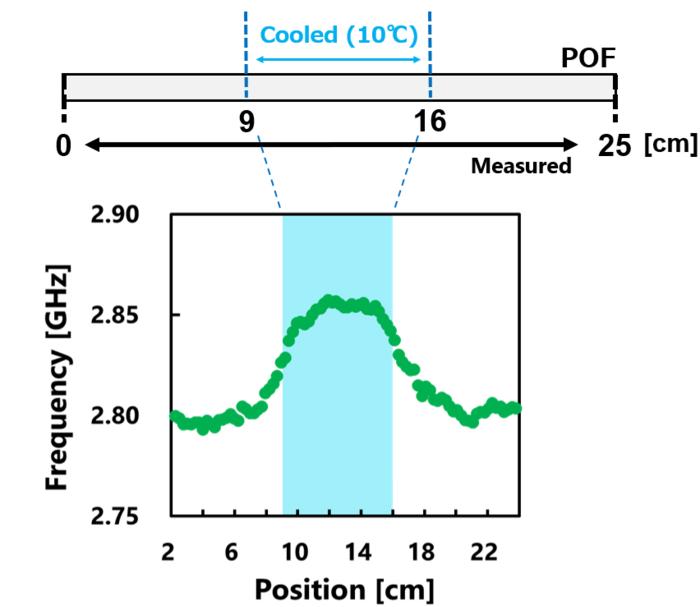
Recent advancements in the realm of optical fiber technology have presented a groundbreaking strategy for significantly boosting the spatial resolution of distributed temperature sensing, particularly utilizing plastic optical fibers (POFs). This innovative approach not only addresses long-standing technical challenges but also showcases the practical implications of enhanced temperature measurement capabilities across various fields. The researchers’ efforts culminate in a state-of-the-art methodology that achieves an impressive theoretical spatial resolution of approximately 4.8 centimeters, offering exciting avenues for future applications in areas that require precise temperature monitoring.
As detailed in research published in the peer-reviewed journal, Optical Fiber Technology, on January 27, 2025, the work of a dedicated team from Yokohama National University has revealed new dimensions in the capabilities of POFs. The lead researcher, Professor Yosuke Mizuno, emphasizes the significance of this research, noting that it represents an essential breakthrough in tackling the limitations of spatial resolution in distributed fiber-optic sensing. By strategically optimizing the properties of modulation amplitude and fiber lengths, the team has successfully demonstrated the feasibility of achieving high-resolution temperature measurements that hold potential utility in structural health monitoring and industrial process control.
Traditional methods of distributed optical fiber sensing often encounter inherent limitations regarding spatial resolution due to various forms of noise interference and the fundamental characteristics of the sensing fibers. These restrictions can compromise the overall accuracy and effectiveness of temperature measurements across varied applications. However, the innovative approach employed by Mizuno and his colleagues pivots on the utilization of perfluorinated graded-index POFs, which exhibit distinctive attributes, including heightened temperature sensitivity while maintaining comparatively low strain sensitivity. This unique advantage positions POFs as remarkably suitable candidates for environments where precision temperature data is paramount.
The researchers’ findings illustrate that careful adjustments to the length of the fiber relative to the measurement range can effectively reduce noise interference. This advancement not only suppresses detrimental noise but also amplifies the modulation capability of the sensors, culminating in a superior spatial resolution. The team’s validation of the method involved accurately detecting temperature variations across a 7.0-centimeter cooled segment within the optical fiber, underscoring the importance of monitoring localized temperature changes that carry significant implications for real-world applications.
Future research is poised to build upon these promising results, exploring pathways to extend the sensing length of the POFs while concurrently preserving this enhanced spatial resolution. The researchers are enthusiastic about the potential to leverage this refined technology to measure various physical parameters beyond temperature, such as pressure and humidity levels. By broadening the scope of measurement capabilities, they aim to refine the applicability of this technique for critical uses in infrastructure monitoring and industrial diagnostics.
The implications of these advancements resonate across a multitude of sectors, highlighting the potential of POFs in enhancing monitoring capabilities. Real-world applications could span industries, including energy management, manufacturing, and civil engineering. The ability to attain high spatial resolution in detecting temperature shifts allows organizations to proactively address issues such as mechanical failure, thermal anomalies, and structural integrity, contributing to improved safety and efficiency in operations.
Ultimately, the collaborative research team includes notable contributors from both Yokohama National University and Shibaura Institute of Technology. Their collective expertise and innovative spirit serve as a catalyst for advancing optical fiber technology, underscoring the importance of interdisciplinary efforts in scientific research. This initiative was partially funded by significant grants from the Japan Society for the Promotion of Science (JSPS), further demonstrating the necessity of continued investment in scientific exploration.
The overall contribution of this research underscores a pivotal shift in fiber-optic sensing technology, igniting excitement within the scientific community as researchers strive to refine this approach. Professor Mizuno emphasizes the transformative potential of this breakthrough, expressing enthusiasm to explore further applications and refine methodologies that promise meaningful solutions to contemporary challenges.
The implications of enhanced spatial resolution in distributed sensing technology herald a new era of precision monitoring, urging further investigations into multifaceted applications. As the scientific community looks to the future, researchers anticipate additional developments that will address the varied needs across industries reliant on optical fiber technology.
In summary, the intersection of technology and empirical research has yielded remarkable outcomes, establishing a foundation for impactful advancements in distributed optical fiber sensing systems. The trajectory of this research ignites hope for the future of accurate and efficient temperature monitoring across an array of sectors, promoting innovation and safety in environments where precise measurements play a critical role in operational success.
Subject of Research: Distributed Temperature Sensing using Plastic Optical Fibers
Article Title: High-resolution distributed temperature sensing along polymer optical fiber using Brillouin optical correlation-domain reflectometry
News Publication Date: January 27, 2025
Web References: Optical Fiber Technology Article
References: DOI – 10.1016/j.yofte.2025.104144
Image Credits: Credit: Yokohama National University
Keywords: Distributed Fiber Optic Sensing, Plastic Optical Fibers, Temperature Measurement, Spatial Resolution, Brillouin Scattering.
Tags: advancements in optical fiber sensingfiber length optimization techniqueshigh-resolution distributed temperature sensingindustrial process control temperature sensingmodulation amplitude optimizationpeer-reviewed optical fiber researchplastic optical fibers technologypractical implications of temperature monitoringProfessor Yosuke Mizuno findingsspatial resolution in temperature measurementstructural health monitoring applicationsYokohama National University research





